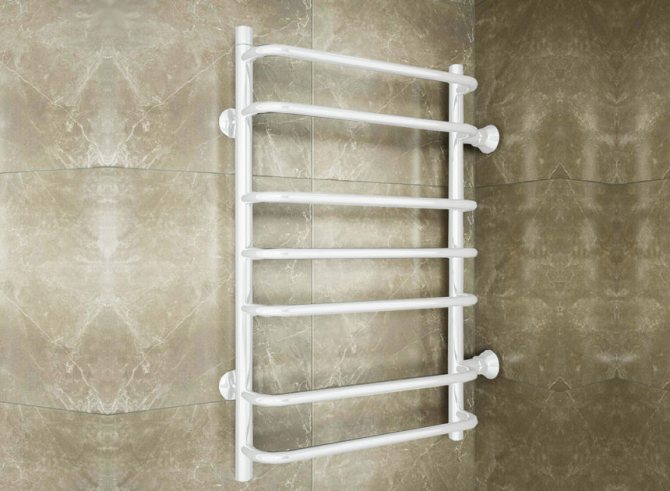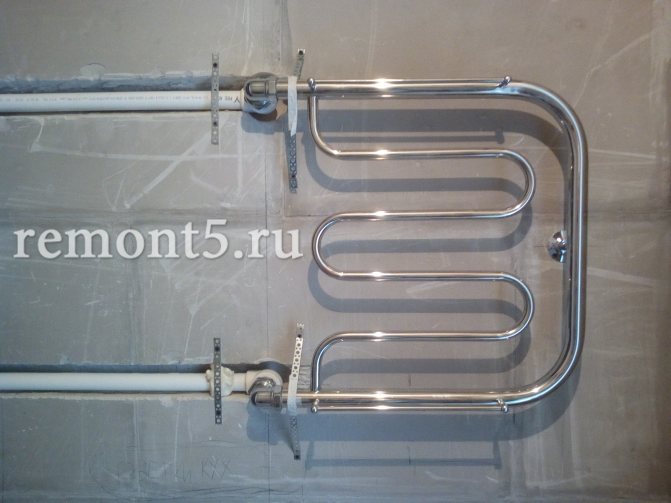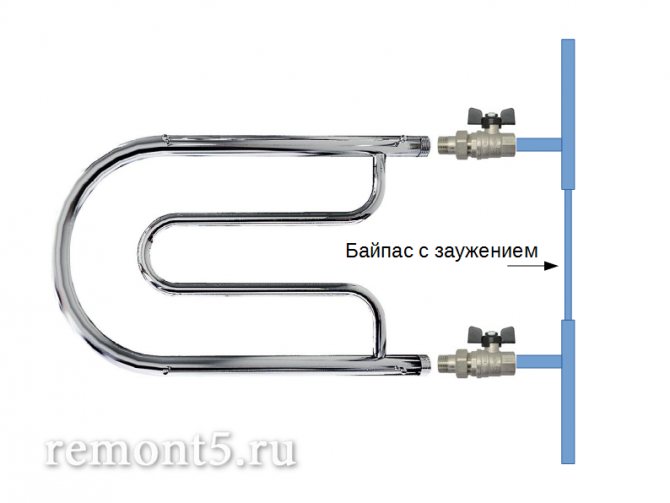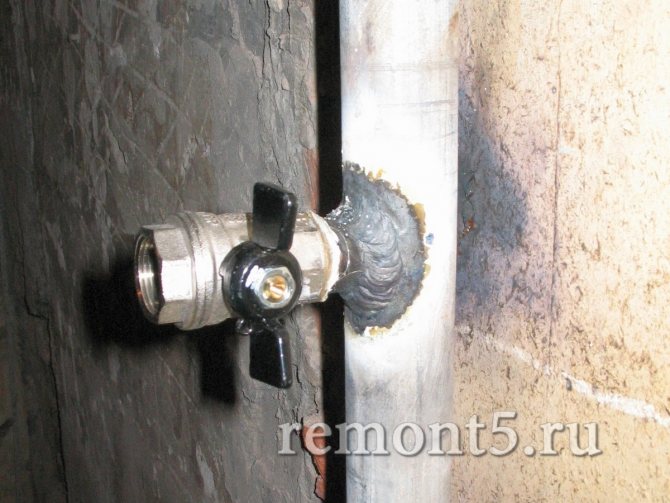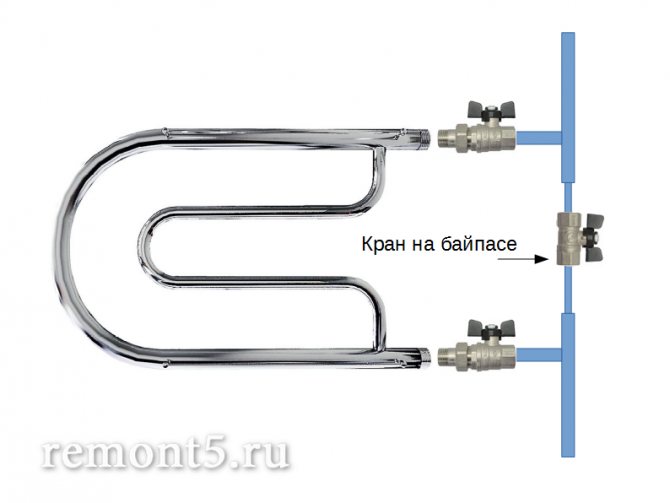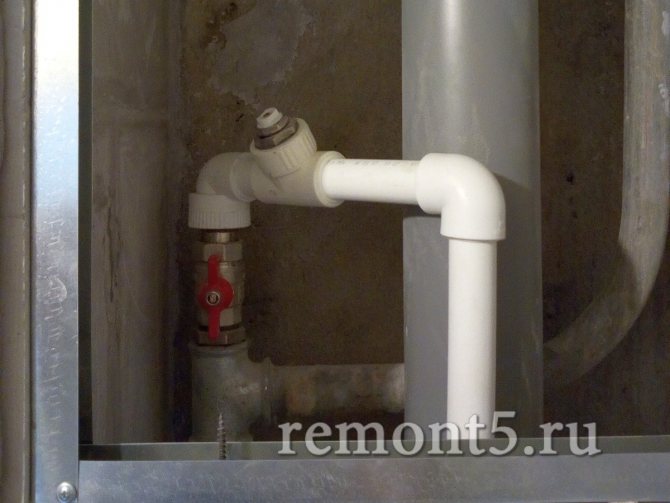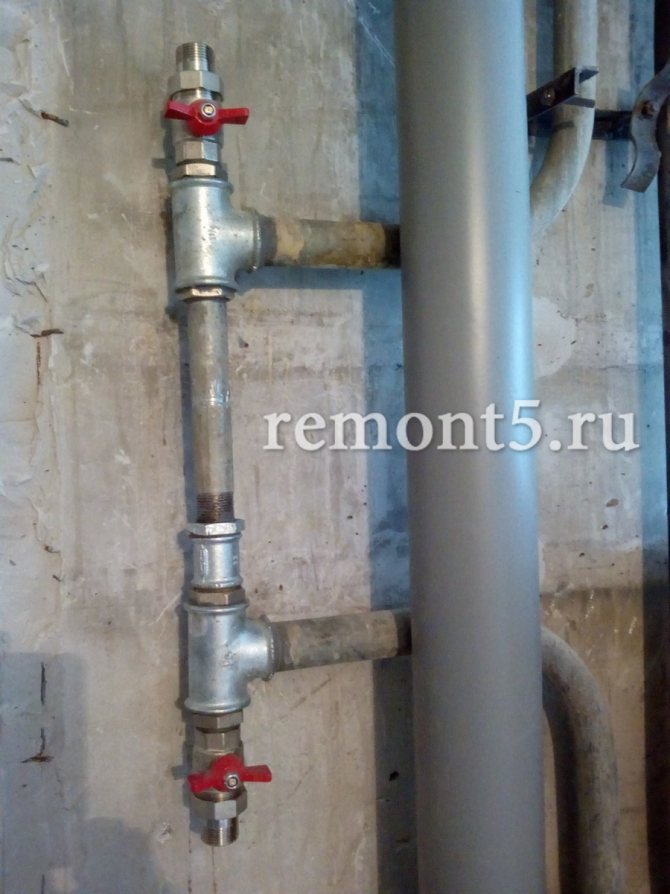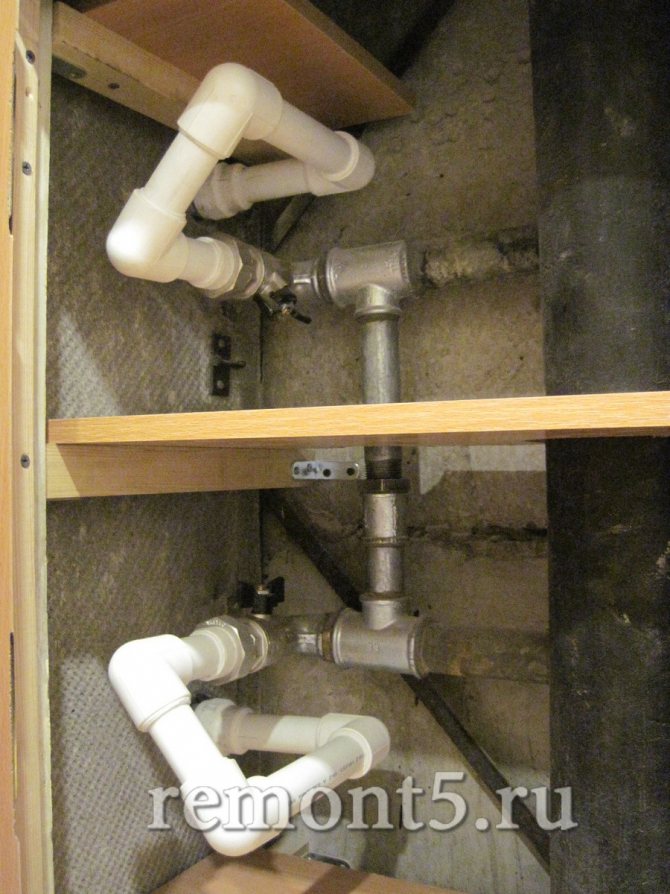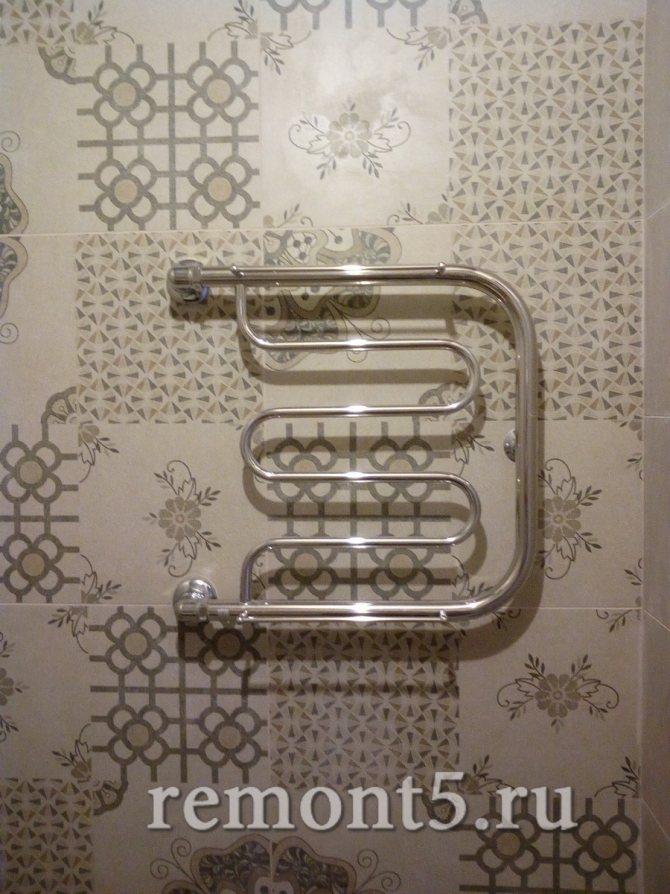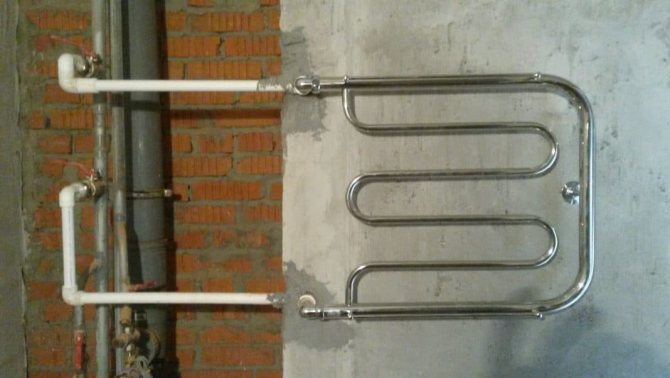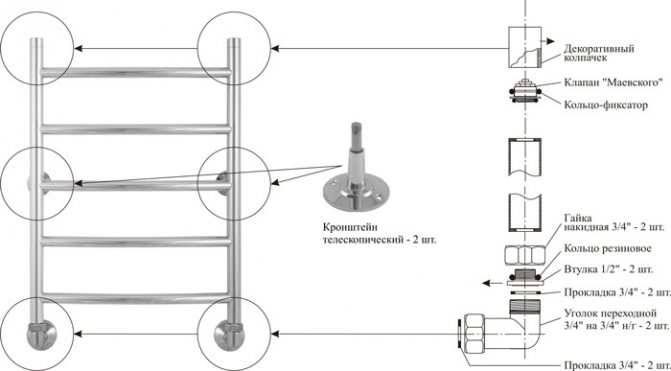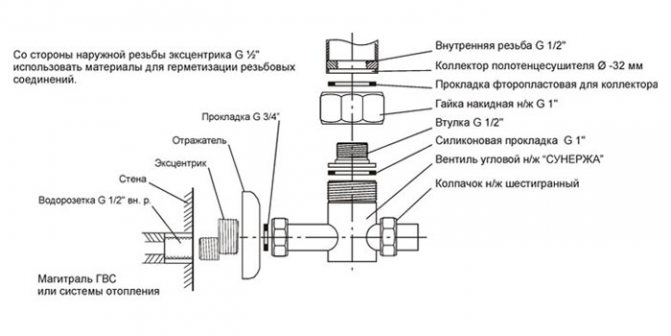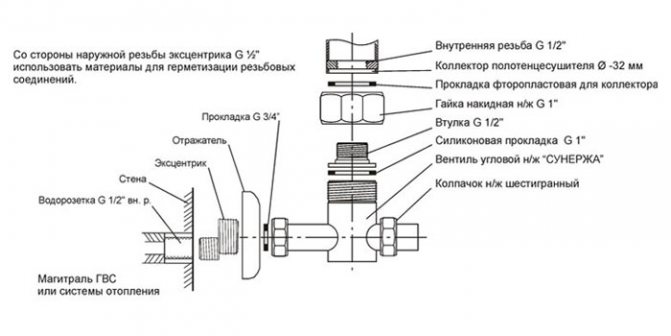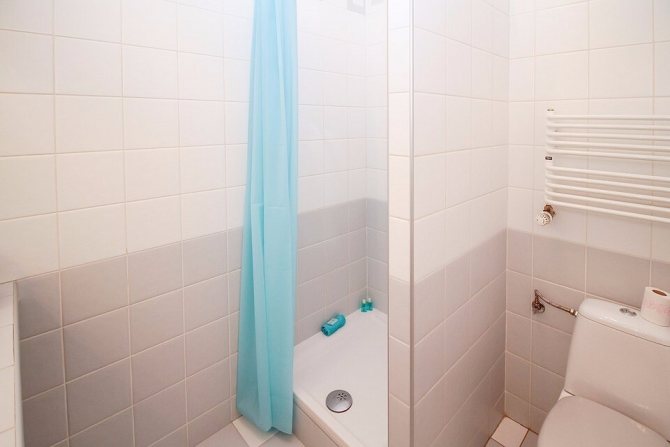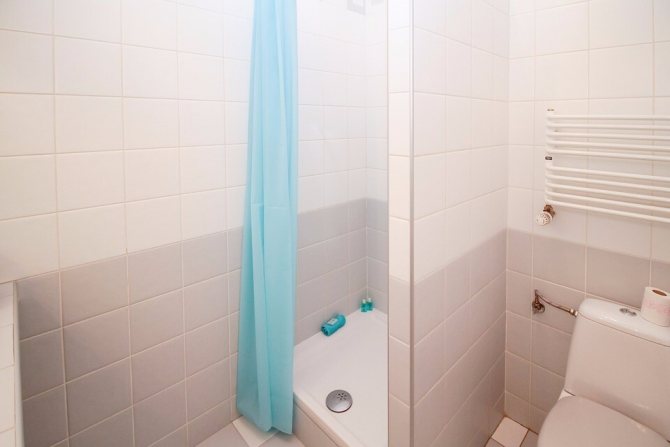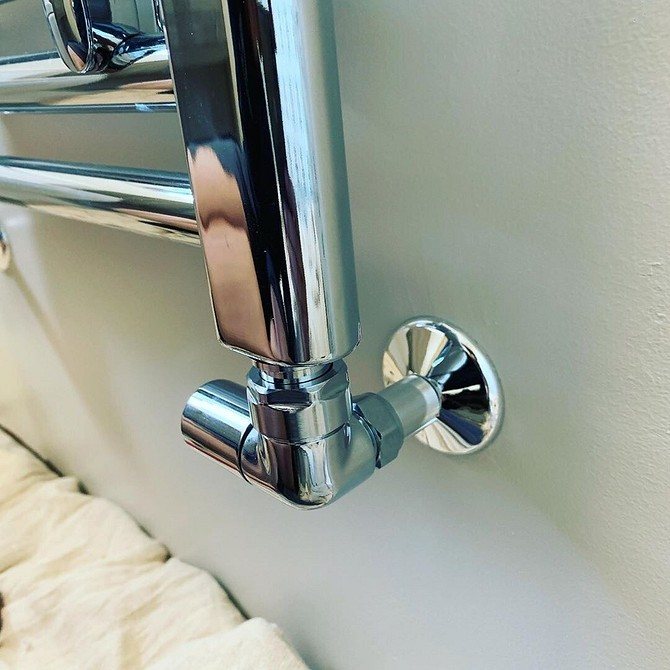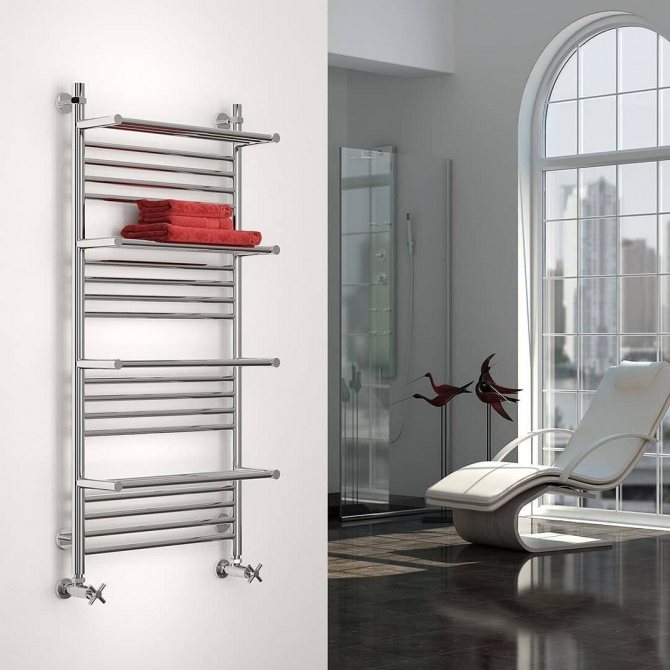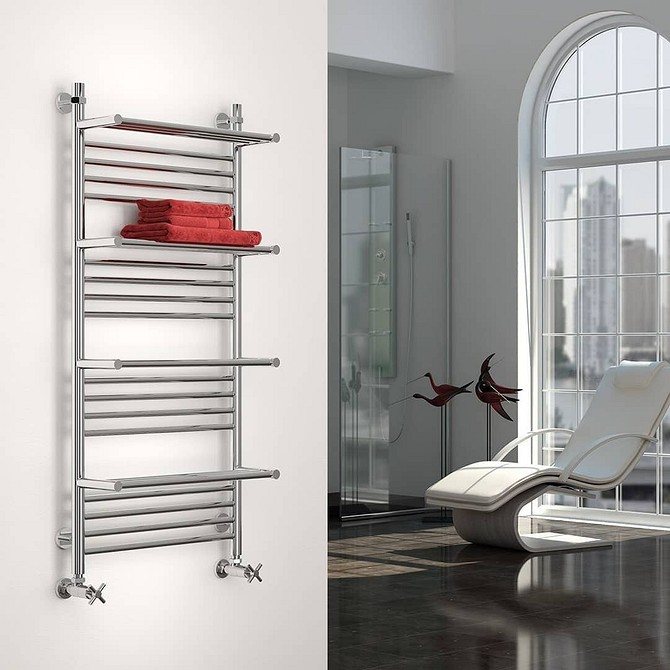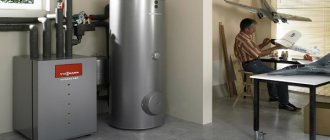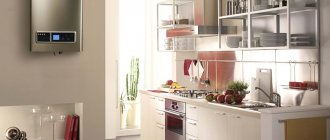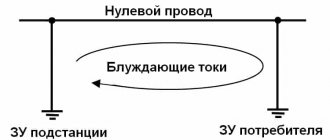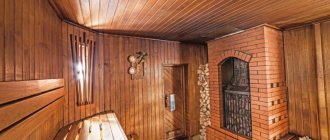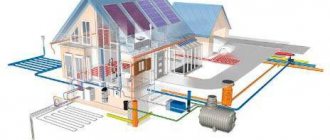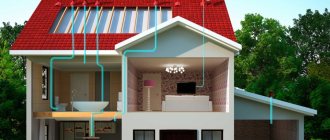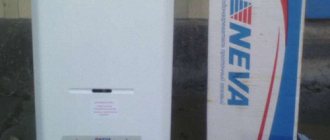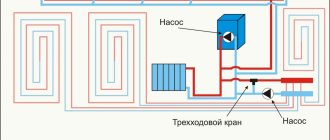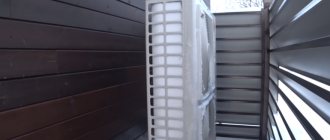The heated towel rail is a multifunctional device that can simultaneously perform both heating and drying functions, and also serves as a design element. This is quite reliable equipment, on which the microclimate of the bathroom depends. However, nothing lasts forever and in some cases this device can fail. Why this happens and what reasons can lead to the fact that the heated towel rail stops performing its main function, namely, it does not heat, we will consider below.
Varieties of modern heated towel rails
There are two main types of heated towel rails: electric and water. Both the first and the second are performed in a very different design, of different sizes, colors, configurations: from a simple curved tube to exquisite models that look more like an interior decoration, but they do their job pretty well.
The device of different types of heated towel rails, of course, is fundamentally different.
In the first case, the device is heated with electricity, in the second, hot water circulates through the pipes. The installation procedure for electric and water models also has significant differences.
What needs to be considered before installing the water model?
The heating medium in water models of heated towel rails is hot water. Most often, the device is connected to a hot water supply system, but this is not always possible. When deciding how to properly install a heated towel rail in the bathroom, such moments should be clarified in advance.
For example, in houses where there is no centralized heating, gas water heaters are used. In such rooms, water heated towel rails are connected to the central heating system. This is not very convenient, since the device works for heating only during the heating season, the rest of the time it is a regular towel rack.
If an electric boiler is used to heat water in the house, it makes sense to purchase a special double-circuit model.
But the owners of private houses with a completely autonomous heating and hot water supply system are much more free in their choice.
If a decision is made to make a heated towel rail part of the heating system of an apartment building, it should be installed in the summer, while the heating season has not yet begun. Usually, utilities are extremely reluctant to agree to turn off the heating of the entire house in the winter cold for the sake of installing this device, which is not necessary for life. And the lack of heating for several hours will hardly please the neighbors.
Before installing a heated towel rail, it is necessary to find out if there is water in the heating system. Usually it is drained for the summer, but this is not always done. You will have to ask the local utilities to check this and turn off the water if necessary.
When installing a heated towel rail as part of the household plumbing, you will also need to shut off the hot water entering the house. Old models of heated towel rails are usually not equipped with taps and a bypass that allows water to bypass the device, so you cannot simply remove it, you will have to ask for the help of local plumbers.
In some cases, it is possible to shut off the water in the water supply or heating system on your own, but for this you need to know exactly how to do it, as well as notify the local public utilities about your “initiative” and obtain their consent.
Finding out how to install a suitable heated towel rail in the bathroom, even before purchasing it, you need to decide on how to connect it. It can be:
- bottom;
- lateral;
- diagonal (for models of the “ladder” type);
- in the center of the bottom.
In the first case, the place where the device is connected to the water supply is at the bottom, and in the second, on the side. Today, water pipes are hidden in the wall or masked with a partition, leaving only places outside for connecting the necessary plumbing. This is how the side-connected models are installed, although the process is quite laborious. It still makes sense to try: the bathroom looks much more attractive this way.
The bottom connection is typical for old houses in which the project provides for the installation of a heated towel rail. The power of the models with the bottom connection is about 10% lower than that of the analogs with the side connection.
To increase the efficiency of the equipment, it makes sense to think over the modification of the water supply system and put a model with a side connection.
Sometimes the diameter of the nozzles of the heated towel rail and the corpse pipe does not match. Special adapters are used to connect them. The diameter of such an adapter must be equal to or greater than the diameter of the water pipes. Otherwise, overpressure may develop in the system, which is fraught with an accident, leaks and other unpleasant problems.
An important parameter is the axial dimensions of the heated towel rail, i.e. the distance separating its entry and exit. Be sure to take into account the diameter of the water pipe in order to select the model of a heated towel rail of the appropriate size. The presence of adapters complicates the installation process and degrades the appearance of the device.
In addition, the risk of leaks increases. If you cannot do without adapters, you should pay special attention to sealing each connection. When choosing taps and fittings, you should take into account the material from which the water pipes are made.
The combination of different metals can cause electrochemical corrosion. In this respect, plastic pipes are much easier to work with.
It is believed that chrome models of towel warmers are more durable than other options. In addition, such devices are characterized by a higher heat transfer.
No circulation in the heated towel rail: reasons
Having done all the procedures to eliminate blockages and dirt, and the device is still cold. Then everything indicates the absence of circulation of the coolant inside the device. This problem is the most difficult, as it requires shutting down the entire heating system and removing the device.
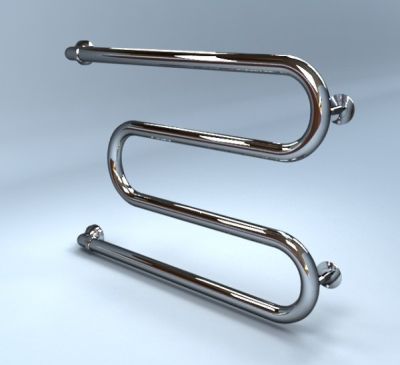
A special pump, which is designed specifically for these purposes, will also help to cope with the circulation in the device. Also, the reason for the lack of circulation is incorrect connection or simply lack of water in the system.
Each breakdown has its own characteristics, therefore, repairs are carried out individually. If there is no circulation in the device, then this may be due to several reasons.
Reasons for the lack of circulation in the device:
- The device was not installed correctly on the hot pipe, namely, there is no return;
- The heated towel rail was installed on the hot return pipe;
- The return line was placed above the level of the device itself.
If the breakdown is inherent in at least one of these reasons, then you need to make some changes to the installation, and this will cost you a significant amount. The easiest way is to simply change the water appliance to an electric one.
The procedure for installing a water heated towel rail
Installation of a water model of a heated towel rail is carried out in several main stages:
- Removing the old device.
- Bypass installation.
- Installation of the top and bottom faucet.
- Installation of a heated towel rail.
- Checking the connections for leaks.
Stage # 1: Removing the old device
So, by the beginning of work, the water in the system should already be reliably shut off. You can remove the old heated towel rail, if it is welded to the pipes, using a conventional grinder, simply by cutting it off.It should be remembered that some of the pipes will have to be threaded, so you need to cut them taking into account these dimensions.
The grinder will also be needed to remove the device with a threaded connection, if it “stuck” to the pipes over time. In other cases, the old heated towel rail is simply unscrewed from the pipes and removed from the brackets on which it hung.
Step # 2: Installing the bypass
A bypass is a special jumper connecting the inlet and outlet of the pipe to which the heated towel rail is connected. It is installed in front of the taps so that the flow of hot water through the pipes is not interrupted when the taps that separate the device from the hot water supply system are closed.
If there is no bypass in the system, for repairs or other manipulations with the device, you will have to turn off the water.
To install the jumper, you need a piece of pipe of a suitable size and diameter. Usually, a pipe with a smaller diameter is used than the dimensions of the pipes of the main line.
The bypass is welded to the pipes of the main line or screwed on with a threaded connection.
Stage # 3: Installing the top and bottom faucet
Before installation, you should purchase two shut-off valves, the thread diameter of which coincides with the diameter of the pipes on which it will be installed.
You can choose conventional taps, which translate to only two positions: “open” and “closed”, or use screw structures to regulate the flow of the coolant entering the device, i.e. the degree of its heating.
Another useful device that is recommended to be installed on a heated towel rail is the Mayevsky tap.
Automatic models of the Mayevsky crane cope with this task even without human intervention. It is very easy to determine that air has entered the device; in this case, the heated towel rail does not heat up enough or cools down completely.
If there are no threads on the pipes, it should be cut using a die with the appropriate characteristics. If there is a thread, but it looks old and worn, it also does not hurt to update it with a special tool to improve the quality of the connection.
Stage # 4: Installing a heated towel rail
Before installing a heated towel rail, consider placing it on the wall. To do this, use special brackets, telescopic holders or clamps. Usually, models from good manufacturers are equipped with the necessary materials and fasteners.
The brackets should be installed on the wall. Usually, for this, the attachment points are marked on the wall, holes are made with a drill, then the brackets are screwed on. Before starting work, read the manufacturer's instructions.
In some cases, a heated towel rail is first installed, and only then it is fixed on the wall.
When installing a heated towel rail, you must remember the special standards. With a pipe diameter of less than 23 mm, a distance of more than 35 mm should be left between the pipe and the wall, and if the pipes of the device are thicker - more than 40 mm - the distance to the wall must be increased to 50 mm.
To connect the heated towel rail to the hot water system, you will need fittings. Angular or straight fittings are used, it depends on the design of the device and the type of its connection. Of course, all connections must be properly sealed to prevent leaks.
Conventional threads are traditionally sealed with linen thread. If enough material has been used for this, it will protrude slightly from the thread after screwing.
If the screwing is significantly difficult, perhaps there is too much winding, but if the connection is easy to screw on, it is likely that you need to add a little more linen seal. FUM tape is used for conical threaded connections.
When installing a heated towel rail, do not use excessive force to tighten all connections, so as not to accidentally damage the threads. In more detail, the process of installing a water heated towel rail is presented in the following video:
Step # 5: Checking the connections for leaks
After all the work is completed, you should again supply water to the system and check the operation of the device. It is advisable to provide maximum load on the device in order to detect even small leaks. In a situation where a heated towel rail is built into the heating system of the house, it is difficult to carry out such a check, because the installation is usually carried out in the summer.
Leaks can only appear before the start of the heating season, when utility workers check the readiness of the system for winter, subjecting it to increased loads. To prevent leakage at a time when the tenants of the apartment are absent, the heated towel rail taps should always be kept closed.
Although the description of the procedure for connecting a heated towel rail looks simple, in practice, all operations require a professional approach. If the home owners do not have the appropriate skills, it makes sense to consult with an experienced plumber or entrust him with the entire range of work.
Heated towel rail leaks slightly - what to do?
Peter, Yekaterinburg asks a question: Heated towel rail leaks a little in the bathroom. What should be done so that the water does not run harder? Can I fix it at home myself or do I have to wait for a locksmith? The expert answers:


Be sure to turn off the water first. Sometimes it is possible to cut off the water supply only to the dryer. If you cannot do this in your apartment, then you will have to temporarily sit without hot water. The best option is not to touch anything else and call a locksmith. He will fix the equipment, or he will have to change the dryer.
If you know how to fix plumbing, you can fix it yourself at home. First of all, you need to determine the place from where the water is oozing. Most often, heated towel rails leak at the joints with pipes - what to do in this case? It is necessary to remove the dryer and inspect the leak. It can run because of the gasket, loose nut, at the place where the dryer is screwed on (thread).
The simplest thing is to change the gasket. It is in almost every home, because it can drip not only from a heated towel rail, but also from a tap or shower. It can be cut from a small piece of rubber according to the pattern using a cutter. After all the changes, screw the dryer back into place, tightening all nuts and fasteners well, and turn on the water. As a rule, the water stops running.
If water is oozing along the threads, you will need flax and plumbing sealant for repairs. Threads need to wrap the junction of the pipes, and cover the top with sealant and let it dry. Then try to connect the heated towel rail.
The situation is worse if the dryer does not leak at the junction with the pipes, but a hole somewhere in it. In this case, you can install a clamp. This is a steel bracket that is placed in place of the leak, then tightened with a screwdriver. The clamp is temporary, the pipe must be welded. It will not work to use it at the bend.
dekormyhome.ru
Installing an electric heated towel rail
The main advantage of an electric heated towel rail is its ease of installation. Like any wall-mounted electrical appliance, it must be hung on the wall and connected to the mains. It remains to turn on the device itself and use it for its intended purpose. An important requirement is compliance with electrical safety rules.
Such a device should be connected only through the so-called "automatic" or RCD - a residual current device. If the socket for connecting the device will be installed directly in the bathroom, be sure to use a special device with protection against moisture.
Such an outlet is mounted in the thickness of the wall; it has a special cover on it. In addition, the appliance must be grounded.
It is believed that the option with an electric heated towel rail is not economically profitable compared to water models, since it increases heat bills. However, the power of such devices is not so great as the consumption of electricity.
This is enough to dry wet terrycloth, but it does not cope very well with the role of a bathroom heater.
The choice is yours!
vannapedia.ru
Why doesn't it warm?
When a heated towel rail stops working, the breakdown may not be difficult. With electrical appliances, for example, this is not the case. Try to understand what burned out there and how to change it. This is a very simple product. Works with water. And the breakdowns are not complicated. They are easy to understand. But disassembling and fixing the breakdown, even when you know what the problem is, may not be so easy.
There are only a few options why it doesn't work and what to do. The fingers of one hand are enough to list them all:
- The hot water pipe can gradually become clogged due to debris and salts.
- An airlock appeared
- Water circulation is disturbed.
- Something is wrong with the valves.
- Clogged up.
Now let's take a look at what to do in each of these situations.
Criteria for choosing a heated towel rail for a bathroom
The durability of the heated towel rail depends on its initial characteristics and compliance with the installation technology. An important role will be played by the compliance of the selected model with operating conditions.
When choosing plumbing equipment, special attention should be paid to the principle of operation, material of manufacture and configuration of the heated towel rail.
Principle of operation and technical characteristics
All models of "towel dryers" for the bathroom are divided into three types:
- water;
- electrical;
- combined.
Water units operate by circulating a hot coolant. The connection is made through a heating or water supply system. The main advantage of such models is energy saving. The disadvantage of a water heated towel rail is the complexity of installation, if the device is not initially included in the communication system of an apartment or house.
In modern apartment buildings, the pressure in the hot water supply system is about 8-10 atmospheres, and in the buildings of the old fund - 5-7 atmospheres. Most of the imported models of heated towel rails have a low working pressure, and the pipe wall thickness does not exceed 1.25 mm. The service life of the device in a typical high-rise building is 1-2 years.
The choice of a coil for a private house is quite extensive, since the pressure in the autonomous heating system is low.
An electric heated towel rail operates autonomously, regardless of the operation of other systems. For work, you need an uninterrupted supply of electricity.
The use of the device is advisable in the following cases:
- fast installation is required without interfering with the heating or water supply system;
- installation of a "backup" heated towel rail;
- the need to place the coil outside the bathroom - a portable electric drying model is optimal.
To avoid excessive consumption of electricity, you should choose the unit by the volume of the room. Optimally, if for 1 sq. m accounts for 140 W of energy - under such conditions, the bath heats up to 22-24 °. If a heated towel rail is needed for the spring and summer period, then low-power models are suitable at the rate of 100 W per 1 sq. m.
Power of "wet" models reaches 2 kW, "dry" devices - 100-200 watts.
Combined heated towel rails can operate in two modes: from the network or from the hot water system. This is the most practical and efficient heating option, but the high cost of the universal coil has put off many buyers.
Plumbing device material
In the manufacture of a heated towel rail coil, three metals are usually used:
- stainless steel;
- copper and brass;
- black steel.
Stainless steel appliances are resistant to moisture, but susceptible to impurities in the water. Over time, sediment forms on the inside of the coil walls, restricting the path of the water flow.
Choosing a stainless steel heated towel rail, preference should be given to chrome-plated models with a wall thickness of 2 mm or more.
Radiators made of brass and copper are distinguished by high heat transfer, however, they have a limited life. When buying, you need to check the passport of the product. It must indicate that the pipes are galvanized from the inside and the heated towel rail is suitable for tapping into the DHW system.
Black steel is capricious to the coolant. Models made of such material are recommended for installation in an autonomous heating system, where pressure drops are excluded. It is permissible to connect a coil with internal anti-corrosion protection to the central DHW system.
Dimensions and shape of the heated towel rail
Size and configuration are determined based on the location of the dryer, the size of the tub, and personal preference. In addition, it is necessary to take into account the cutting method: side, diagonal, top or bottom.
The classic M- and U-shapes are affordable and are optimal for replacing worn-out Soviet coils. The "ladder", "foxtrot" and "modern" radiators are more spacious. The area allows you to place the laundry like a stationary dryer.
The heated towel rail should be compatible with the bathroom design and not clutter up the space.
I heard that a heated towel rail can be connected to hot water - this is so or problematic
No problems - if you have it connected to a steam heating system (it's bad that we are flying cold) - it is unscrewed (cut off), it is shunted by another pipe, and the heated towel rail is welded into the hot water supply system (depending on the design, you need to either weld 2 squeegees, or immediately heated towel rail). Without welding (either gas0- or electro-with an inverter - + a good welder, carefully weld the joints) DO NOT DO
instead of a heating battery, they connect it for sure
in any apartment it is connected to hot water)
do you have that connected to the cold?
Like that it would work in the summer as well? In principle, nothing complicated ... switch the old pipes to the riser and that's it
In the bathroom, demolish your battery and put this one instead of it, then what is in the picture you have, at which you can turn it on and off yourself whenever you want, and in the summer it is very convenient when you turn off hot water, it will work for you and there will be no dampness bathroom, I have this for 16 years, very happy. By the way, you can put it in any place, even on the wall (behind) where the bathtub itself stands, the sizes of such dryers are different, and their appearance is also now varied.
A-priory. The heated towel rail is connected ONLY with the DHW system. The other is simply absurd. And where is your connection to the heating in the bathroom? This is not possible at all. But if only through the ass.
In a good half of the houses, the towel is connected to the GW. BUT ... This is possible only if the diameter of the hot water pipe is not less than 32. If you have less, then I do not recommend connecting - without a jumper it can plant a riser, but with a jumper (as in general it should be) it may not work itself. The one in the photo is thin and is designed to be connected to an individual riser. If the parameters of the hot water pipe in your house are not suitable for inserting a towel into it, and you want to dry it in the summer, then I recommend buying and installing an electric one. Power consumption - from 60 W (300-500 rubles per year). And turn it on and off whenever you want
https://yur-ma.ru/ystanovka-vodyanogo-polotencesushitelya.php read here. Great article on your topic
Good evening, I have a question, you can hang a towel on the heating system supply pipe, or be sure to enter from the supply, and exit to the return line. Thanks in advance
touch.otvet.mail.ru
Connecting a heated towel rail: DHW or heating
Before you install a water heated towel rail in the bathroom, you need to decide on the method of connecting it.
There are two options available:
- Connection to the DHW system. The method guarantees year-round heating. The device heats up when hot water is consumed - overnight the heated towel rail cools down even if it is directly switched on through the riser.
- Insert into the heating system. The option is relevant in the absence of a centralized hot water supply network. Thanks to the forced circulation of the coolant, the coil remains warm around the clock. The disadvantage is that drying functions only in the cold season.
When replacing the method of connecting a heated towel rail in an apartment building, you will need to develop a project and approve it in housing and communal services. Registration of the package of documents will take about a month.
Did you stop heating the heated towel rail after a planned DHW shutdown?
Ladder-shaped heated towel rails have undeniable advantages over ordinary coils, but at the same time they are technically more complicated. If a water heated towel rail has been installed for a long time and worked well before, but after a planned shutdown / activation of hot water, as we do in the summer, it stopped heating, then most likely during the installation of your ladder a slope was not made for the underwater and outlet pipes and for this reason an air lock is formed, which interferes with natural circulation.
Hopefully watching the video below will solve your problem.
General installation requirements
Installation of a heated towel rail with a "water" principle of operation is carried out in compliance with a number of conditions:
# 1. The diameter of the pipes of the device must correspond to the diameter of the riser; tapering from the installed fittings is unacceptable.
No. 2. It is necessary to provide a jumper between the drying outlets. The bypass performs a number of tasks:
- maintaining the speed of water circulation throughout the riser;
- separation of coolant flows allows you to keep heat for subsequent points of water intake;
A weighty plus of switching on the closing sections, bypasses, is the ability to turn off the heated towel rail for repairs without stopping the operation of the system as a whole.
No. 3. It is prohibited to install shut-off valves in the pipeline section up to the bypass and directly on the bulkhead.
Failure to comply with the requirement entails:
- slowing down the circulation of water through the riser and a drop in the temperature of the coolant;
- deterioration of pressure in apartments located in the direction of the water supply.
The closing sections can be equipped with the usual ball valves on the bypass and supply line, or more functional three-way valves, allowing the coolant to be directed either to the bypass or to the radiator.
No. 4. The recommended height for drying towels according to SNiP is 120 cm from the floor.
No. 5. Limit distances between the heater and the wall cladding:
- 3.5-4 cm - if the diameter of the coil is 2.5 cm or less;
- 5-7 cm - with a pipe section of more than 2.5 cm.
If a bypass is provided in the wiring diagram, then shut-off ball valves can be installed at the outlet and inlet of the device.
Eliminate the blockage in the pipe
Suppose it seems to you that the reason why the heated towel rail does not heat is precisely in the clogging of the pipe.
In general, to establish the cause is an art. We can assume and then check, gradually eliminating options.
So, let's say the reason is a blockage in the pipe. What to do?
- First, turn off the water.
- After that, we remove the heated towel rail.
- Put it in the tub.
- Remove any unnecessary parts that prevent the water from being drained.
- We drain the water.
- Next, clean it with a hard wire, a rod or a brush.
- We tap very carefully so as not to wrinkle.
- We pour out everything that fell off thanks to us.
- We wash with a strong pressure of water.
- We repeat everything several times
It's all? Not!
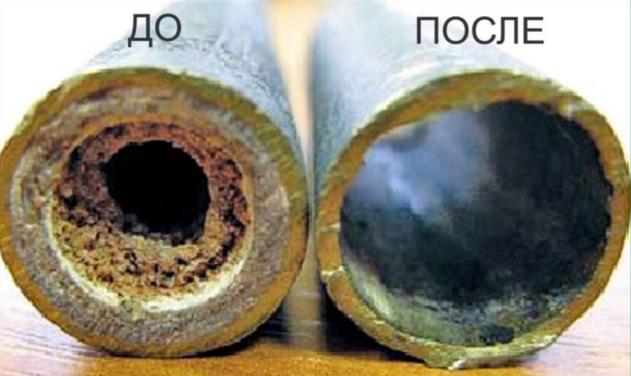

To bring the matter to the end, it is necessary to pour hydrochloric acid into the heated towel rail "to the brim". How to do it?
- It is best not to do this in an apartment.
- Install the heated towel rail so that nothing can flow out of it.
- After filling with acid, wait 5-10 minutes.
- After pouring out the acid, rinse with more and more water.
That's it? Again, no!
The acid will not completely remove the deposits. Something will dissolve. But it will only soften some things. And here we need to repeat all the procedures with the brush described above.
Finally, we rinse everything well with water.
Now that's all. What do we do next? Reinstalling a heated towel rail?
Early! First, we clean all the parts of the eyeliner. We clean everything in the same way. Everything can be mechanically cleaned, or chemically cleaned. If you decide to use acid, dilute it a little. Otherwise, it may damage parts. Valves that cannot be cleaned or that are faulty are replaced with new ones. Ruthlessly.
Now we put it in place and connect everything as it was.
Recommended and Invalid Punching Schemes
The principle of the "gravity pump" is the cornerstone of the coil's performance. A competent inset ensures natural circulation and performance of the radiator. The development of a DIY installation scheme for a water heated towel rail is carried out in accordance with the design of a specific model and the location of the riser in the bathroom.
Side and diagonal connection
For most devices, a tie-in with a coolant supply through the upper outlet and outlet from the bottom is considered optimal. This is achieved with universal connections, the diagrams of which are shown below.
Benefits of the universal tie-in:
- performance does not depend on the direction and rate of water supply in the riser;
- after turning off the circulation, air bleeding is not required;
The universal version of the tie-in allows you to position the heated towel rail at any convenient distance from the riser.
Conditions for the operation of the circuit:
- The lower point of the tie-in is located below the connection pipe to the radiator, and the upper tie-in, respectively, is above the upper outlet. The slope of the supply pipes is 2-3 cm per meter. The horizontal connection is permissible for pipes with a cross section of 32 mm, as well as if the distance to the riser is less than 2 m.
- Supply pipes - no kinks or humps. Otherwise, the system is airy and natural circulation stops.
- The optimal diameter of the supply pipes: ¾ inch steel, 25 mm - reinforced polypropylene.
- It is advisable to insulate the pipes. This requirement is especially important for hidden installation of a plastic pipeline.
A fully functional side / diagonal tapping scheme with a narrowed bypass. Plumbers resort to this design on a previously installed heated towel rail, if there is no need to completely change the design of the riser.
Displacement of the bypass is justified if you want to keep the old supplies to the riser. With this method of connection, it is not recommended to use a narrowed jumper. The main requirement is the upper supply of the coolant.
Some models of dryers are designed for bottom connection. The insertion is carried out according to three main schemes.
Bottom connection implementation requirements:
- The lower outlet must be located below the heated towel rail.
- It is advisable to insulate the supply pipes.
- The top outlet of the riser pipe, when using an offset or narrowed bypass, is located below the point of connection to the instrument.
The optimum slope is about 2 cm per meter of pipe. The fulfillment of this condition ensures the independence of the circuit from the direction of the water flow.
Possible forced tie-in options
With lateral connection, some deviations from the typical recommended circuits are permissible.
The basic conditions of the tie-in remain unchanged.The difference is in the points of connection of the heated towel rail with the riser, as well as in the presence of vertical sections at the inlet and outlet of the device.
An alternative sidecut is shown below. The top of the heated towel rail is located above the upper outlet. After turning off the water, it will be necessary to bleed air from the coil.
The lower inset can also be somewhat modified. The need to place pipes from the riser at a minimum distance to the floor forces both ascending piping to be increased. If all the requirements of the bottom connection are met, the system works without failures.
Incorrect wiring diagrams
Inexperienced craftsmen sometimes do not adhere to the recommended schemes. As a result, the drying remains cold with an uninterrupted supply of hot water. Examples of possible omissions are shown below.
In both versions, the device is located below the lower outlet from the riser. The coolant descending downward cools and becomes trapped. The water is not pushed back, since there is the pressure of the coolant flow from above.
Air accumulates in the formed "hump". Over time, the air lock shuts off the circulation in the radiator and the heated towel rail cools down.
The variant presented below combines two errors at the same time. The scheme is obviously not working.
Step-by-step installation of a water heated towel rail
The technology for installing a water heated towel rail with your own hands is the same for different connection schemes. The step-by-step course of work includes dismantling a worn-out device, supplying pipes from a riser, installing taps and fastening a coil.
Preparation of tools and materials
The set of tools required to install and replace a heated towel rail depends on the type of water pipes in the room. For installation through polypropylene pipes you will need: ball valves; mounting brackets; polypropylene pipes; soldering iron and knife for cutting PP pipes.
The standard equipment for a heated towel rail includes:
- transition corners;
- silicone gaskets;
- locking knots;
- telescopic brackets;
- crane "Mayevsky".
It is advisable to use single metal components in the system to avoid electrolytic corrosion.
Dismantling of old equipment
Before dismantling an obsolete coil, it is necessary to coordinate actions with the house management organization. Disconnecting the riser from the water requires a special permit.
Following actions:
- If the towel dryer is not integral with the hot line, then the screw connections just need to be unscrewed.
- If the device is welded to the riser, then it should be cut off with a grinder. The remainder of the pipe feed should be sufficient for threading.
- Remove the old device from the brackets.
The cutout in the riser in height must exceed the distance between the nozzles of the new device by the length of the couplings and squeegees required for inserting the bypass jumper
Installation of bypass and ball valves
The coil can be fastened without installing a bypass, but experts recommend providing a jumper in advance. Ball valves are installed at the ends of the heated towel rail. If necessary, it will be possible to shut off the coolant supply to the device, while water will circulate freely through the riser.
To install taps on pipe sections, cut a new thread using a die of the required diameter. If, after dismantling the old device, the thread has survived, then it is enough to "drive out" it with a die to improve the connection. Install shut-off valves on the prepared pipes.
Attaching the heated towel rail
The procedure for "hanging" and connecting the device is as follows:
- Apply markings on the wall for the brackets - it is necessary to observe the horizontal position of the coil.
- Prepare holes and insert dowels into them.
- Screw the brackets to the heated towel rail, attach the device to the wall and fix with screws.It is important to adhere to the recommended distance between the radiator and the wall cladding.
- Connect the unit to the valves on the lintel using fittings, seal the connections with linen tape.
Straight or elbow threaded fittings are used depending on the type of connection.
Features of installing electrical models
Unlike water models, electric dryers can be installed anywhere, since they do not depend on the location of heating pipes and hot water supply. In this case, special attention should be paid to the quality of the wiring.
Installation requirements for electric heated towel rails:
- The place of installation is selected taking into account the level of protection of the device against moisture. The distance to the bathroom or washbasin is at least 60 cm.
- The minimum distance to the floor is 20 cm, to the wall - 30 cm, to the surface of furniture - 75 cm.
- The heating device must not be placed directly under the socket.
The connection to the mains is carried out in accordance with the international standard NFC-15-100.
Wiring under the heated towel rail is carried out in compliance with electrical safety standards in rooms with high humidity:
- connection via a three-core cable with grounding;
- only hidden wiring is permissible;
- the socket must have a rubber seal and a cover that covers the contact holes;
- copper wires of the VVGng and VVGng-LS brands are used for the power grid.
A prerequisite for the installation and operation of electrical devices is the use of an RCD that turns off the device when the current operating characteristics are exceeded.
Useful video on the topic
Recommendations for choosing a towel dryer are shown in the video clip:
The installation process of a water heated towel rail is shown in the video clip:
The technology for installing a heated towel rail depends on the selected model. The performance of a water device is determined by a well-designed and executed tie-in scheme. When installing an electric model, special attention is paid to operational safety. It is better to entrust the installation of the combined "coil" to professionals.
sovet-ingenera.com

